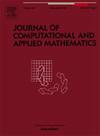Construction of quasi-localized dual bases in reproducing kernel Hilbert spaces
IF 2.1
2区 数学
Q1 MATHEMATICS, APPLIED
Journal of Computational and Applied Mathematics
Pub Date : 2025-02-05
DOI:10.1016/j.cam.2025.116545
引用次数: 0
Abstract
A straightforward way to represent the kernel approximant of a function, known by a finite set of samples, within a reproducing kernel Hilbert space is through the canonical dual pair. The canonical dual pair consists of the basis of kernel translates and the corresponding Lagrange basis. From a numerical perspective, one is particularly interested in dual pairs such that the dual basis is quasi-local meaning that it can be well approximated using only a small subset of the data sites. This implies that the inverse Gramian is approximately sparse. In this case, the kernel approximant is efficiently computable by multiplying a sparse matrix with the data vector. We present two methods for finding such quasi-localized dual bases. First, we adapt the idea of localizing the Lagrange basis, which yields an approximate canonical dual pair and extend this idea to derive a new, symmetric preconditioner for kernel matrices. Second, we use samplets to obtain multiresolution versions of dual bases. Samplets are localized discrete signed measures constructed such that their respective measure integrals of polynomials up to a certain degree vanish. Therefore, the kernel matrix and its inverse are compressible to sparse matrices in samplet coordinates for asymptotically smooth kernels. We provide benchmark experiments in two spatial dimensions to demonstrate the compression power of both approaches and apply the new preconditioner to implicit surface reconstruction in computer graphics.
求助全文
约1分钟内获得全文
求助全文
来源期刊
CiteScore
5.40
自引率
4.20%
发文量
437
审稿时长
3.0 months
期刊介绍:
The Journal of Computational and Applied Mathematics publishes original papers of high scientific value in all areas of computational and applied mathematics. The main interest of the Journal is in papers that describe and analyze new computational techniques for solving scientific or engineering problems. Also the improved analysis, including the effectiveness and applicability, of existing methods and algorithms is of importance. The computational efficiency (e.g. the convergence, stability, accuracy, ...) should be proved and illustrated by nontrivial numerical examples. Papers describing only variants of existing methods, without adding significant new computational properties are not of interest.
The audience consists of: applied mathematicians, numerical analysts, computational scientists and engineers.

 求助内容:
求助内容: 应助结果提醒方式:
应助结果提醒方式:


